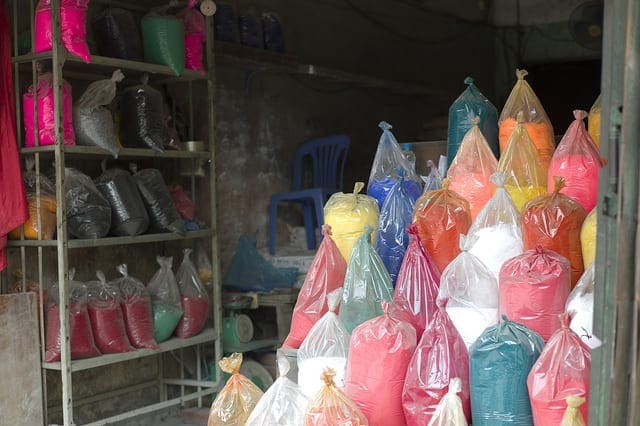Decision trees are a simple and powerful predictive modeling technique, but they suffer from high-variance.
This means that trees can get very different results given different training data.
A technique to make decision trees more robust and to achieve better performance is called bootstrap aggregation or bagging for short.
In this tutorial, you will discover how to implement the bagging procedure with decision trees from scratch with Python.
After completing this tutorial, you will know:
- How to create a bootstrap sample of your dataset.
- How to make predictions with bootstrapped models.
- How to apply bagging to your own predictive modeling problems.
Kick-start your project with my new book Machine Learning Algorithms From Scratch, including step-by-step tutorials and the Python source code files for all examples.
Let’s get started.
- Update Jan/2017: Changed the calculation of fold_size in cross_validation_split() to always be an integer. Fixes issues with Python 3.
- Update Feb/2017: Fixed a bug in build_tree.
- Update Aug/2017: Fixed a bug in Gini calculation, added the missing weighting of group Gini scores by group size (thanks Michael!).
- Update Aug/2018: Tested and updated to work with Python 3.6.

How to Implement Bagging From Scratch With Python
Photo by Michael Cory, some rights reserved.
Descriptions
This section provides a brief description to Bootstrap Aggregation and the Sonar dataset that will be used in this tutorial.
Bootstrap Aggregation Algorithm
A bootstrap is a sample of a dataset with replacement.
This means that a new dataset is created from a random sample of an existing dataset where a given row may be selected and added more than once to the sample.
It is a useful approach to use when estimating values such as the mean for a broader dataset, when you only have a limited dataset available. By creating samples of your dataset and estimating the mean from those samples, you can take the average of those estimates and get a better idea of the true mean of the underlying problem.
This same approach can be used with machine learning algorithms that have a high variance, such as decision trees. A separate model is trained on each bootstrap sample of data and the average output of those models used to make predictions. This technique is called bootstrap aggregation or bagging for short.
Variance means that an algorithm’s performance is sensitive to the training data, with high variance suggesting that the more the training data is changed, the more the performance of the algorithm will vary.
The performance of high variance machine learning algorithms like unpruned decision trees can be improved by training many trees and taking the average of their predictions. Results are often better than a single decision tree.
Another benefit of bagging in addition to improved performance is that the bagged decision trees cannot overfit the problem. Trees can continue to be added until a maximum in performance is achieved.
Sonar Dataset
The dataset we will use in this tutorial is the Sonar dataset.
This is a dataset that describes sonar chirp returns bouncing off different surfaces. The 60 input variables are the strength of the returns at different angles. It is a binary classification problem that requires a model to differentiate rocks from metal cylinders. There are 208 observations.
It is a well-understood dataset. All of the variables are continuous and generally in the range of 0 to 1. The output variable is a string “M” for mine and “R” for rock, which will need to be converted to integers 1 and 0.
By predicting the class with the most observations in the dataset (M or mines) the Zero Rule Algorithm can achieve an accuracy of 53%.
You can learn more about this dataset at the UCI Machine Learning repository.
Download the dataset for free and place it in your working directory with the filename sonar.all-data.csv.
Tutorial
This tutorial is broken down into 2 parts:
- Bootstrap Resample.
- Sonar Dataset Case Study.
These steps provide the foundation that you need to implement and apply bootstrap aggregation with decision trees to your own predictive modeling problems.
1. Bootstrap Resample
Let’s start off by getting a strong idea of how the bootstrap method works.
We can create a new sample of a dataset by randomly selecting rows from the dataset and adding them to a new list. We can repeat this for a fixed number of rows or until the size of the new dataset matches a ratio of the size of the original dataset.
We can allow sampling with replacement by not removing the row that was selected so that it is available for future selections.
Below is a function named subsample() that implements this procedure. The randrange() function from the random module is used to select a random row index to add to the sample each iteration of the loop. The default size of the sample is the size of the original dataset.
|
1 2 3 4 5 6 7 8 |
# Create a random subsample from the dataset with replacement def subsample(dataset, ratio=1.0): sample = list() n_sample = round(len(dataset) * ratio) while len(sample) < n_sample: index = randrange(len(dataset)) sample.append(dataset[index]) return sample |
We can use this function to estimate the mean of a contrived dataset.
First, we can create a dataset with 20 rows and a single column of random numbers between 0 and 9 and calculate the mean value.
We can then make bootstrap samples of the original dataset, calculate the mean, and repeat this process until we have a list of means. Taking the average of these sample means should give us a robust estimate of the mean of the entire dataset.
The complete example is listed below.
Each bootstrap sample is created as a 10% sample of the original 20 observation dataset (or 2 observations). We then experiment by creating 1, 10, 100 bootstrap samples of the original dataset, calculate their mean value, then average all of those estimated mean values.
|
1 2 3 4 5 6 7 8 9 10 11 12 13 14 15 16 17 18 19 20 21 22 23 24 25 26 27 28 29 30 31 32 33 |
from random import seed from random import random from random import randrange # Create a random subsample from the dataset with replacement def subsample(dataset, ratio=1.0): sample = list() n_sample = round(len(dataset) * ratio) while len(sample) < n_sample: index = randrange(len(dataset)) sample.append(dataset[index]) return sample # Calculate the mean of a list of numbers def mean(numbers): return sum(numbers) / float(len(numbers)) seed(1) # True mean dataset = [[randrange(10)] for i in range(20)] print('True Mean: %.3f' % mean([row[0] for row in dataset])) # Estimated means ratio = 0.10 for size in [1, 10, 100]: sample_means = list() for i in range(size): sample = subsample(dataset, ratio) sample_mean = mean([row[0] for row in sample]) sample_means.append(sample_mean) print('Samples=%d, Estimated Mean: %.3f' % (size, mean(sample_means))) |
Running the example prints the original mean value we aim to estimate.
We can then see the estimated mean from the various different numbers of bootstrap samples. We can see that with 100 samples we achieve a good estimate of the mean.
|
1 2 3 4 |
True Mean: 4.450 Samples=1, Estimated Mean: 4.500 Samples=10, Estimated Mean: 3.300 Samples=100, Estimated Mean: 4.480 |
Instead of calculating the mean value, we can create a model from each subsample.
Next, let’s see how we can combine the predictions from multiple bootstrap models.
2. Sonar Dataset Case Study
In this section, we will apply the Random Forest algorithm to the Sonar dataset.
The example assumes that a CSV copy of the dataset is in the current working directory with the file name sonar.all-data.csv.
The dataset is first loaded, the string values converted to numeric and the output column is converted from strings to the integer values of 0 to 1. This is achieved with helper functions load_csv(), str_column_to_float() and str_column_to_int() to load and prepare the dataset.
We will use k-fold cross validation to estimate the performance of the learned model on unseen data. This means that we will construct and evaluate k models and estimate the performance as the mean model error. Classification accuracy will be used to evaluate each model. These behaviors are provided in the cross_validation_split(), accuracy_metric() and evaluate_algorithm() helper functions.
We will also use an implementation of the Classification and Regression Trees (CART) algorithm adapted for bagging including the helper functions test_split() to split a dataset into groups, gini_index() to evaluate a split point, get_split() to find an optimal split point, to_terminal(), split() and build_tree() used to create a single decision tree, predict() to make a prediction with a decision tree and the subsample() function described in the previous step to make a subsample of the training dataset
A new function named bagging_predict() is developed that is responsible for making a prediction with each decision tree and combining the predictions into a single return value. This is achieved by selecting the most common prediction from the list of predictions made by the bagged trees.
Finally, a new function named bagging() is developed that is responsible for creating the samples of the training dataset, training a decision tree on each, then making predictions on the test dataset using the list of bagged trees.
The complete example is listed below.
|
1 2 3 4 5 6 7 8 9 10 11 12 13 14 15 16 17 18 19 20 21 22 23 24 25 26 27 28 29 30 31 32 33 34 35 36 37 38 39 40 41 42 43 44 45 46 47 48 49 50 51 52 53 54 55 56 57 58 59 60 61 62 63 64 65 66 67 68 69 70 71 72 73 74 75 76 77 78 79 80 81 82 83 84 85 86 87 88 89 90 91 92 93 94 95 96 97 98 99 100 101 102 103 104 105 106 107 108 109 110 111 112 113 114 115 116 117 118 119 120 121 122 123 124 125 126 127 128 129 130 131 132 133 134 135 136 137 138 139 140 141 142 143 144 145 146 147 148 149 150 151 152 153 154 155 156 157 158 159 160 161 162 163 164 165 166 167 168 169 170 171 172 173 174 175 176 177 178 179 180 181 182 183 184 185 186 187 188 189 190 191 192 193 194 195 196 197 198 199 200 201 202 203 204 205 206 207 208 209 |
# Bagging Algorithm on the Sonar dataset from random import seed from random import randrange from csv import reader # Load a CSV file def load_csv(filename): dataset = list() with open(filename, 'r') as file: csv_reader = reader(file) for row in csv_reader: if not row: continue dataset.append(row) return dataset # Convert string column to float def str_column_to_float(dataset, column): for row in dataset: row[column] = float(row[column].strip()) # Convert string column to integer def str_column_to_int(dataset, column): class_values = [row[column] for row in dataset] unique = set(class_values) lookup = dict() for i, value in enumerate(unique): lookup[value] = i for row in dataset: row[column] = lookup[row[column]] return lookup # Split a dataset into k folds def cross_validation_split(dataset, n_folds): dataset_split = list() dataset_copy = list(dataset) fold_size = int(len(dataset) / n_folds) for i in range(n_folds): fold = list() while len(fold) < fold_size: index = randrange(len(dataset_copy)) fold.append(dataset_copy.pop(index)) dataset_split.append(fold) return dataset_split # Calculate accuracy percentage def accuracy_metric(actual, predicted): correct = 0 for i in range(len(actual)): if actual[i] == predicted[i]: correct += 1 return correct / float(len(actual)) * 100.0 # Evaluate an algorithm using a cross validation split def evaluate_algorithm(dataset, algorithm, n_folds, *args): folds = cross_validation_split(dataset, n_folds) scores = list() for fold in folds: train_set = list(folds) train_set.remove(fold) train_set = sum(train_set, []) test_set = list() for row in fold: row_copy = list(row) test_set.append(row_copy) row_copy[-1] = None predicted = algorithm(train_set, test_set, *args) actual = [row[-1] for row in fold] accuracy = accuracy_metric(actual, predicted) scores.append(accuracy) return scores # Split a dataset based on an attribute and an attribute value def test_split(index, value, dataset): left, right = list(), list() for row in dataset: if row[index] < value: left.append(row) else: right.append(row) return left, right # Calculate the Gini index for a split dataset def gini_index(groups, classes): # count all samples at split point n_instances = float(sum([len(group) for group in groups])) # sum weighted Gini index for each group gini = 0.0 for group in groups: size = float(len(group)) # avoid divide by zero if size == 0: continue score = 0.0 # score the group based on the score for each class for class_val in classes: p = [row[-1] for row in group].count(class_val) / size score += p * p # weight the group score by its relative size gini += (1.0 - score) * (size / n_instances) return gini # Select the best split point for a dataset def get_split(dataset): class_values = list(set(row[-1] for row in dataset)) b_index, b_value, b_score, b_groups = 999, 999, 999, None for index in range(len(dataset[0])-1): for row in dataset: # for i in range(len(dataset)): # row = dataset[randrange(len(dataset))] groups = test_split(index, row[index], dataset) gini = gini_index(groups, class_values) if gini < b_score: b_index, b_value, b_score, b_groups = index, row[index], gini, groups return {'index':b_index, 'value':b_value, 'groups':b_groups} # Create a terminal node value def to_terminal(group): outcomes = [row[-1] for row in group] return max(set(outcomes), key=outcomes.count) # Create child splits for a node or make terminal def split(node, max_depth, min_size, depth): left, right = node['groups'] del(node['groups']) # check for a no split if not left or not right: node['left'] = node['right'] = to_terminal(left + right) return # check for max depth if depth >= max_depth: node['left'], node['right'] = to_terminal(left), to_terminal(right) return # process left child if len(left) <= min_size: node['left'] = to_terminal(left) else: node['left'] = get_split(left) split(node['left'], max_depth, min_size, depth+1) # process right child if len(right) <= min_size: node['right'] = to_terminal(right) else: node['right'] = get_split(right) split(node['right'], max_depth, min_size, depth+1) # Build a decision tree def build_tree(train, max_depth, min_size): root = get_split(train) split(root, max_depth, min_size, 1) return root # Make a prediction with a decision tree def predict(node, row): if row[node['index']] < node['value']: if isinstance(node['left'], dict): return predict(node['left'], row) else: return node['left'] else: if isinstance(node['right'], dict): return predict(node['right'], row) else: return node['right'] # Create a random subsample from the dataset with replacement def subsample(dataset, ratio): sample = list() n_sample = round(len(dataset) * ratio) while len(sample) < n_sample: index = randrange(len(dataset)) sample.append(dataset[index]) return sample # Make a prediction with a list of bagged trees def bagging_predict(trees, row): predictions = [predict(tree, row) for tree in trees] return max(set(predictions), key=predictions.count) # Bootstrap Aggregation Algorithm def bagging(train, test, max_depth, min_size, sample_size, n_trees): trees = list() for i in range(n_trees): sample = subsample(train, sample_size) tree = build_tree(sample, max_depth, min_size) trees.append(tree) predictions = [bagging_predict(trees, row) for row in test] return(predictions) # Test bagging on the sonar dataset seed(1) # load and prepare data filename = 'sonar.all-data.csv' dataset = load_csv(filename) # convert string attributes to integers for i in range(len(dataset[0])-1): str_column_to_float(dataset, i) # convert class column to integers str_column_to_int(dataset, len(dataset[0])-1) # evaluate algorithm n_folds = 5 max_depth = 6 min_size = 2 sample_size = 0.50 for n_trees in [1, 5, 10, 50]: scores = evaluate_algorithm(dataset, bagging, n_folds, max_depth, min_size, sample_size, n_trees) print('Trees: %d' % n_trees) print('Scores: %s' % scores) print('Mean Accuracy: %.3f%%' % (sum(scores)/float(len(scores)))) |
A k value of 5 was used for cross-validation, giving each fold 208/5 = 41.6 or just over 40 records to be evaluated upon each iteration.
Deep trees were constructed with a max depth of 6 and a minimum number of training rows at each node of 2. Samples of the training dataset were created with 50% the size of the original dataset. This was to force some variety in the dataset subsamples used to train each tree. The default for bagging is to have the size of sample datasets match the size of the original training dataset.
A series of 4 different numbers of trees were evaluated to show the behavior of the algorithm.
The accuracy from each fold and the mean accuracy for each configuration are printed. We can see a trend of some minor lift in performance as the number of trees is increased.
|
1 2 3 4 5 6 7 8 9 10 11 12 13 14 15 |
Trees: 1 Scores: [87.8048780487805, 65.85365853658537, 65.85365853658537, 65.85365853658537, 73.17073170731707] Mean Accuracy: 71.707% Trees: 5 Scores: [60.97560975609756, 80.48780487804879, 78.04878048780488, 82.92682926829268, 63.41463414634146] Mean Accuracy: 73.171% Trees: 10 Scores: [60.97560975609756, 73.17073170731707, 82.92682926829268, 80.48780487804879, 68.29268292682927] Mean Accuracy: 73.171% Trees: 50 Scores: [63.41463414634146, 75.60975609756098, 80.48780487804879, 75.60975609756098, 85.36585365853658] Mean Accuracy: 76.098% |
A difficulty of this method is that even though deep trees are constructed, the bagged trees that are created are very similar. In turn, the predictions made by these trees are also similar, and the high variance we desire among the trees trained on different samples of the training dataset is diminished.
This is because of the greedy algorithm used in the construction of the trees selecting the same or similar split points.
The tutorial tried to re-inject this variance by constraining the sample size used to train each tree. A more robust technique is to constrain the features that may be evaluated when creating each split point. This is the method used in the Random Forest algorithm.
Extensions
- Tune the Example. Explore different configurations for the number of trees and even individual tree configurations to see if you can further improve results.
- Bag Another Algorithm. Other algorithms can be used with bagging. For example, a k-nearest neighbor algorithm with a low value of k will have a high variance and is a good candidate for bagging.
- Regression Problems. Bagging can be used with regression trees. Instead of predicting the most common class value from the set of predictions, you can return the average of the predictions from the bagged trees. Experiment on regression problems.
Did you try any of these extensions?
Share your experiences in the comments below.
Review
In this tutorial, you discovered how to implement bootstrap aggregation from scratch with Python.
Specifically, you learned:
- How to create a subsample and estimate bootstrap quantities.
- How to create an ensemble of decision trees and use them to make predictions.
- How to apply bagging to a real world predictive modeling problem.
Do you have any questions?
Ask your questions in the comments below and I will do my best to answer.








Thanks for this example in python from scratch. I think the reason your score stays the same is because you are using the entire dataset to select your split attributes. This leads to similar trees and thus a small variance of the ensemble set. If you change your code, in such a way you get more variance in the trees, you will see an increase in performance of the ensemble. One solution is to alter this code snippet:
# Build a decision tree
def build_tree(train, max_depth, min_size):
root = get_split(train)
split(root, max_depth, min_size, 1)
return root
Thanks for the tip!
Hi Jason,
Just wondering have you modified your code according his tip? ( cannot see any difference between your code and his suggestion)
Yes, it has been fixed. It used to use the whole dataset.
thanks for the great tutorial!
I have re-written this script using sklearn for easy implementation:
https://gist.github.com/JovanSardinha/2c58bd1e7e3aa4c02affedfe7abe8a29
Nice work!
Hi Jason,
Minor tip – In the string to integer conversion – I found that the unique set gets created in somewhat random order in repeat runs of this and others scripts that use this function. To avoid this I have changed the line to read-
unique = sorted(set(class_values))
This results in creating the same lookup dictionary every time. I ran across this when I was using the lookup dictionary to create nicely mapped printouts of the intermediate data.
Great tip, thanks Alex!
Hey, this link is not working
See this:
https://machinelearningmastery.com/bagging-ensemble-with-python/
I am trying to implement your work into R.
However I am lost in translation. Specifically, a line in your “Calculate the Gini index for a split dataset” function. The following line in this function is a tough one to translate into R.
p = [row[-1] for row in group].count(class_val) / size
Would you mind helping me out? Or considering posting a R implementation of this code?
Many thanks in advance!
Sorry, I don’t have the capacity to translate code for you or debug new R implementations.
The problem i faced is i got different results when tuning parameters using grid search how can i fix it thanks
This is to be expected:
https://machinelearningmastery.com/faq/single-faq/why-do-i-get-different-results-each-time-i-run-the-code
I have implemented bagging with random forest regressor in python and i’ve tuned parameters but no where the results are converging. Training accuracy @ 95% and Testing acc @ 55%.
X = np.array([Depth, Dist, Soft, Stiff, sand, Sand, Stiff_C, Invert, FP, Penetr, Pitching, GP, GF]).T
Y = np.array(Settlement)
Y = Y.reshape(len(Y),)
data = [X, Y]
data = np.random.shuffle(data)
rf = result = BaggingRegressor(RandomForestRegressor(), n_estimators = 270,
bootstrap = True, oob_score = True, random_state = 42, max_features = 6)
rf.fit(X,Y)
pred = rf.predict(X)
r2 = r2_score(Y, pred)
plt.scatter(x=Y, y=pred)
plt.show()
print(“Train Accuracy : ” + str(r2))
print(“Test Accuracy : ” + str(rf.oob_score_))
Perhaps try the sklearn implementation of the algorithms?
Hi Jason, Nice tutorial. However, I am wondering how bagging is different from that of cross validation? For a large dataset these are doing the same ‘kind’ of process. Could you please explain that?
Similar, in that they both perform resampling, but different ends.
In bagging we seek high variance because we are creating an ensemble for prediction.
In CV we seek a balance between bias and variance to achieve a reliable estimate of model performance on unseen data.
Thanks for clearing me that
Hello how can plot accuracy in boostraping using sklearn classifier?
Do you mean estimating the performance of a classifier using the bootstrap?
This tutorial will help:
https://machinelearningmastery.com/a-gentle-introduction-to-the-bootstrap-method/
Hi, when we create an ensemble with bagging technique, where each model (lets say a cnn) is trained on a different dataset, test set is the same for each model and for the ensemble, but how about validation set that is used during training the models? Can I use the same dataset to validate all models, or do I need to use a different one for each of them since each model is trained on a different dataset. Thanks in advance!
You can use the out of bag samples as a validation dataset for each bagged model.
Thank yo so much!!
You’re welcome!
Thank you for this tutorial. I have a question please.
I believe the line
max(set(predictions), key=predictions.count)
would be the same as
max(predictions, key=predictions.count)
Is that correct?
No, the set() locates unique values.
Am fairly new to this so likely is user error, am using pyCharm Community
=== did I miss something?? ===
============================= test session starts =============================
collecting … collected 1 item
ex_bagging_from_scratch.py::test_split ERROR [100%]
test setup failed
file D:\DomiPy\venv\ex_bagging_from_scratch.py, line 81
def test_split(index, value, dataset):
E fixture ‘index’ not found
> available fixtures: cache, capfd, capfdbinary, caplog, capsys, capsysbinary, doctest_namespace, monkeypatch, pytestconfig, record_property, record_testsuite_property, record_xml_attribute, recwarn, tmp_path, tmp_path_factory, tmpdir, tmpdir_factory
> use ‘pytest –fixtures [testpath]’ for help on them.
D:\DomiPy\venv\ex_bagging_from_scratch.py:81
Sorry to hear that, perhaps some of these tips will help:
https://machinelearningmastery.com/faq/single-faq/why-does-the-code-in-the-tutorial-not-work-for-me
Hi Jason,
Thank you very much for the informative tutorial!
I’m a beginner so please bear with me! 🙂
As far as I understand, this implementation looks similar to the algorithm in this paper https://doi.org/10.1016/S0031-3203(02)00121-8 which i’m trying to implement for a regression problem where the dataset is small (230 data points).
My question is: how can I change the code to use a linear regression with L2 regularization?
Hi Lima,
I’m eager to help, but I don’t have the capacity to customize the code for your specific needs.
I get a lot of requests like this. I’m sure you can understand my rationale.
I do have some ideas that might help:
Perhaps I already have a tutorial with the change you’re asking for? Search the blog.
Perhaps you can try to make the change yourself?
Perhaps you can add a comment below the post with the change you need and I or another reader can make a suggestion?
Perhaps you can hire a contractor or programmer to make the change?
Perhaps you can post a description of the code needed on stackoverflow.com?